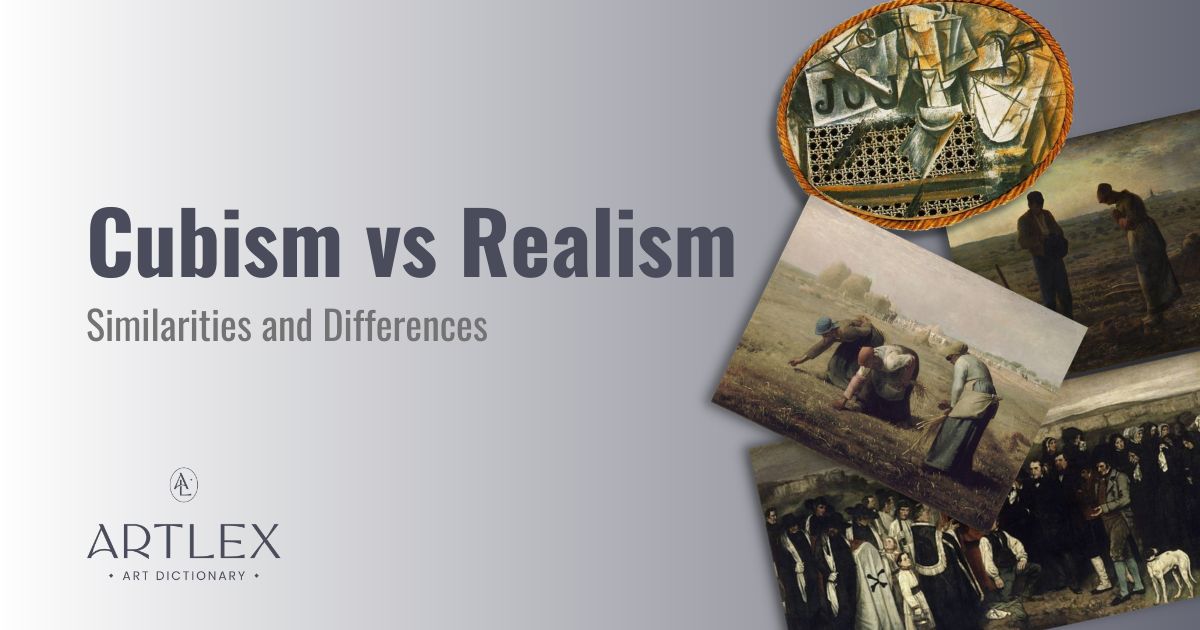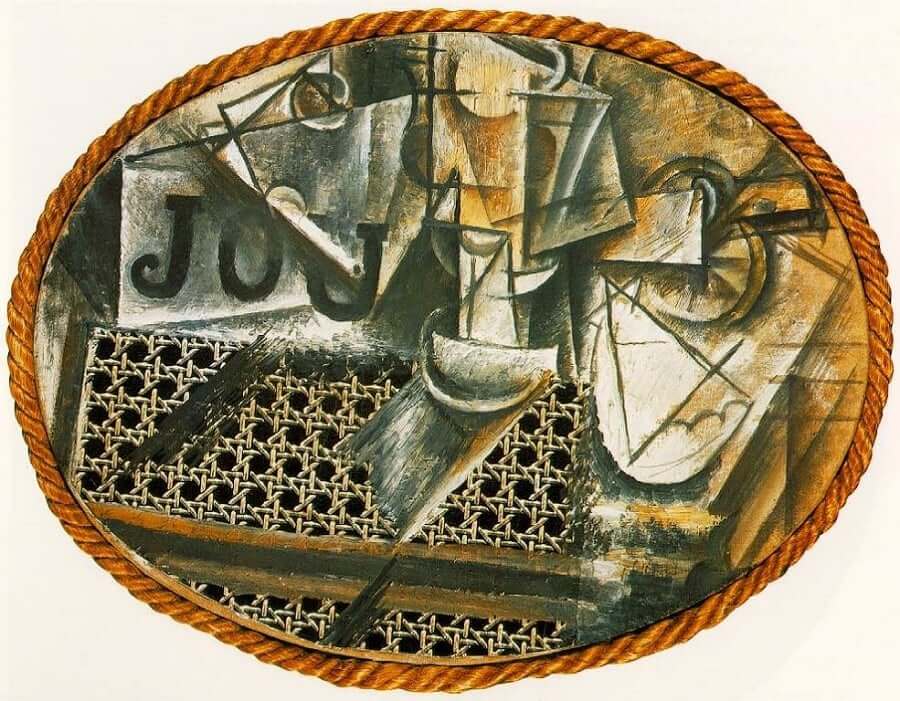
Cubism is a Western art movement that began around 1907 in Paris, France and dissolved in 1914 due to the First World War. Cubism was led by artists Pablo Picasso and Georges Braque, who experimented with form and perspective to achieve the fragmented composition that was central to the movement. In this way and others, Cubism challenged traditional representations of figures, still lifes, and landscapes.
Realism is also a Western art movement that emerged in France around 1840 and lasted well into the late 19th century. The goal of French Realism was to represent scenes from everyday life truthfully and without embellishment. The movement was a direct revolt against Romanticism, which glorified its subjects and often depicted scenes from history, mythology, and the Christian bible. French artists Gustave Courbet, Jean-François Millet, Honoré Daumier, and Jean-Baptiste-Camille Corot led the Realist movement in France.
Cubism and Realism have many similarities, including: truthfully depicting reality, rejecting high art conventions, and using a limited color palette.
Cubism and Realism also have many differences, including the use of perspective, depiction of social classes, and abstraction.
Cubism and Realism Similarities
Cubism and Realism have many similarities, including truthfully depicting reality, rejecting high art conventions, and using a limited color palette.
Cubism vs. Realism: Truthful Depiction of Reality
Despite having two distinct styles, Cubism and Realism both aimed for truthful depictions of reality. Cubists Pablo Picasso and Georges Braque represented objects based on the use of multiple perspectives to build up a composite, conceptual representation.
Realist artists saw that the world was changing rapidly, modernizing along with the Industrial Revolution. Realists wanted their art to reflect their contemporary environment–their perceptions of everyday life.
Jean-Francois Millet depicts three gleaners gathering bits of leftover wheat from a recent harvest in his painting The Gleaners, pictured below:

Realism also overlapped with the advent of photography, which marked a shift in artists’ vision from revering the past to examining the present.
Cubism vs. Realism: Rejection of High Art
Cubism and Realism rejected the stylistic conventions of high art in many ways. The Royal Academy in Paris, France supported the belief that art should be inspired by classical tradition, a reflection of national culture, and teach the viewer about morality. Realists typically painted scenes of everyday life, which were initially considered “low” and too gritty for the Paris salons.
Cubism and Realism embraced life as it was. Both reimagined the Royal Academy’s accepted conventions of landscape, still life, and portraiture, reworking the traditions of modeling, foreshortening, and perspective.
Cubism vs. Realism: Limited Color Palette
Cubist and Realist paintings often seem gloomy because they possess a limited color palette. Realist painters sought to ignore the idealized beauty found in movements such as Romanticism and Neoclassicism. A primary way of ignoring idealized beauty included applying earthy tones to the canvas rather than vivid hues, as seen in The Angelus, by Jean-Francois Millet, pictured below:

Cubism and Realism Differences
Cubism and Realism also have many differences, including the use of perspective, depiction of social classes, and abstraction.
Cubism vs. Realism: Perspective
Cubism features a non-traditional approach to perspective. Instead of painting subjects using one-point or two-point perspective, Cubists isolated every possible perspective visible within their subject matter and combined it into a single picture plane. This shattered the illusion of depth that more naturalistic painting styles used in movements such as Realism, Romanticism, and Neoclassicism. Realism, though subversive for its subject matter, still used traditional perspective to depict subjects in space.
Cubism vs. Realism: Depiction of Social Classes
Realist artists depicted individuals of all social classes in a similar manner, avoiding the idealistic beauty often reserved for high status subjects. Realism was a controversial art movement because it criticized the upper classes and revealed the ideals of the emerging working class. By painting scenes of working class life in urban and rural France, Realist painters elevated people of the working class to a position (and scale!) typically reserved for depictions of the wealthy, heroic, or fictional.
Gustave Courbet’s A Burial at Ornans depicts a burial where individuals from different social classes are gathered in public, as seen below:

By extension, Cubism was not concerned with wealth or class. Cubist artists channeled everyday life and the consequences of the Industrial Revolution by adding collage elements to their paintings. Bottle labels, newspaper clippings, and other virtually valueless ephemera were often included in the Synthetic Cubism pieces of Picasso and Braque.
Picasso’s Still Life with Chair Caning pictured below includes rope, chair caning, and oilcloth, everyday objects used in mass production:

Cubism vs. Realism: Abstraction
Realism depicted real life in a naturalistic manner. Realist painters made almost no attempt to gloss over or obscure what modern life in city streets looked like, including people enjoying popular public entertainment or making their way home from work. While Realist paintings often had more painterly brushwork than previous movements, abstraction was not a stylistic concern.
Cubist artists, on the other hand, obscured their subjects in an aim to see them more clearly. To the contemporary viewer, early Cubist works appear abstract and would now constitute Abstract Art. However, Cubism was concerned with the impact of mechanization on society and modern life, not overt abstraction. Some Cubists, such as Robert Delaunay, embraced abstraction as a “pure” form of art and assembled movements such as Abstract Cubism and Orphism reflect those interests.
How did Realism Influence Cubism?
Picasso began painting as a child and his artistic career spanned almost 80 years. Realism did not have a direct influence in the development of Cubism, however Pablo Picasso’s earliest works reflect elements of Realist style. His paintings were characterized by naturalistic brushwork, everyday subject matter, and a realistic color palette.
Much of Picasso’s work during the 1890s was shaped by Spanish Old Masters, such as El Greco and Velázquez, but he produced less idealized representations of subjects in his portraits. After moving to Paris in 1904, Picasso was influenced by Henri Toulouse-Lautrec and developed a social consciousness while embracing this new movement of “Modernism.” Picasso experimented with many modern influences on style and subject matter, which undoubtedly played an important role in the development of Cubism.
What other Art Movements are Similar to Cubism and Realism?
In addition to Cubism and Realism, there are many Western art movements that claim to represent life and subjects truthfully. However, the meaning of truth varies drastically from movement to movement.
Realism is the first art movement of its time that depicted the working class without embellishment and, in doing so, was very controversial. In fact, many modernist movements were controversial for breaking artistic tradition engrained by European art academies.
Symbolism was also similar to Realism in that it sought to represent absolute truths through metaphorical images, but it was a reaction to Realism and Naturalism. Surrealism unearthed truths about the unconscious mind. Expressionism sought truth through unfiltered expression of subjectivity and emotion–the list goes on.
